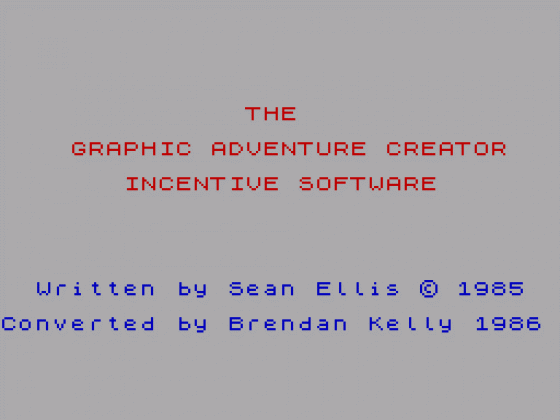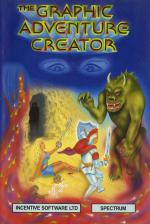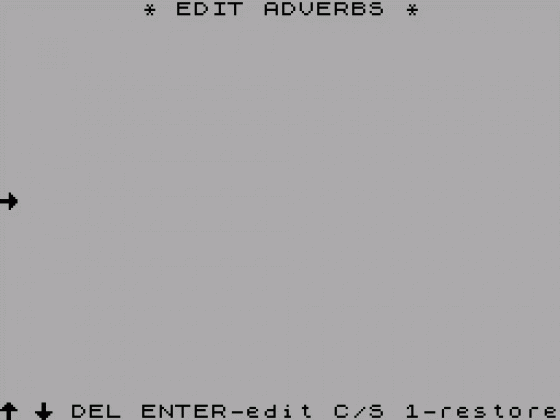
Crash
 1st September 1986
1st September 1986
Categories: Review: Software
Author: Sean Masterson
Publisher: Incentive
Machine: Spectrum 48K
Published in Crash #32
A new way of writing adventures
The Graphic Adventure Creator
Over a years development work has gone into Incentive's adventure-writing utility. The Graphic Adventure Creator, and it has already appeared for the Amstrad, earning a very favourable response. The Spectrum adventure-writing utility market is still dominated by The Quill - can GAC step in as the new king? Sean Masterson takes a close look, and rustles up a couple of comments from the Crash crew…
The Graphic Adventure Creator is a sophisticated adventure writing package that arrives on a single cassette. Adventures written with the package include multiple commands in a single input, advanced graphics, full word recognition and a host of other features intended to make this the state-of- the-art adventure writing utility.
The packaging is very neat. GAC comes in a large format cassette holder complete with a glossy manual. The printing isn't remarkable but the manual explains every detail of the utility with care and precision sometimes with accompanying graphics where it is thought they may help. Loading is achieved easily thanks to use of fast loading techniques and the user is presented with a title/credit screen followed by a menu page. GAC itself leaves approximately 23K free for your adventure once it resides in memory, but larger adventures could be created with multiple loading techniques this should mean that the adventure can be as big as the author desires. Complete adventures run independently of the utility.

To give you an idea of just what this package is capable of, Incentive include a couple of mini adventures with the package. One is a pure text offering, the other uses graphics. If the full solution to an example adventure is known, the entire game may be played in one input. The result is like a short story, punctuated with a series of commands and it forms an impressive demonstration of GAC's power. There is also a Quickstart file which loads a group of common verbs, conditions and other details to allow rapid creation of small games or time to be saved when commencing larger works.
As the graphics capability is the most obviously powerful aspect of the utility, let's begin with a look at the graphics creation routines... As with any utility of this type, the more complex the graphics, the less memory is available for the rest of the adventure. While this might suggest the need for simplistic graphics, Incentive have made sure that the adventure writer has the opportunity to make up complex images should they be required. Block or line graphics may be implemented with ease, and a host of devices have been included to make the process as painless as possible.
Four pure colours may be used in an illustration, though these may be stippled in any combination to give the effect of up to ten colours and textures on screen. Bright and flash options are also provided.
The top two thirds of the graphic creation screen is surrounded by the frame in which the image is created. Below this, the pen and paper symbol are permanently displayed along with the border colour. The pen rests on the paper during the drawing process for clarity during picture creation. Unfortunately the options menu is not displayed (as it is on the Amstrad version of GAC) which means serious study of the manual is required until the commands become second nature. This is my only gripe.
The drawing routines supplied cater for all needs. Ellipses, Dots, Boxes, Fill and Shade, slow and fast drawing, picture merging, and picture or stage deletion are all included along with a picture scan that allows analysis and alteration of any stage in the creation. An attribute grid showing possible problems due to the Spectrum's colour limitations is also available as a screen overlay.
The merging facility is very important from a memory saving angle. If a picture is drawn and then has a frame decoration added (previously drawn as a separate picture), only three bytes are used. This cuts down tremendously on memory used if repetitive pictures are used.
Most of the features work smoothly but the exception to this neatness is the Fill command. This isn't perfect and an optimum position within the area to be filled needs to be found. Even then, in an awkward shape, a gap may be left. This can be rectified by implementing Fill a second time from a better position and the final result will be no different from that achieved with a more capable command routine. However, the finished picture takes up more memory. This is arguably offset by the fact that this Fill command takes up very little memory itself and is particularly fast. On the final picture, it makes no real difference anyway.
The ability to look back or delete back either a single step or a whole picture makes correction and modification of pictures very simple indeed. The effect of open or closed doors is just one example of how these features cater for the kind of conditions often required of graphics in adventures. Because it is possible to change the ink during the course of a picture creation and then change it back again, when the whole picture is asked for in the adventure, a limited form of animation is possible. Things such as flashing lights, flowing water or other relatively small changes to detail to a picture can be attained with the minimum of effort.
Up to 10,000 separate pictures can be held in a GAC game, though it's extremely unlikely that more than a fraction of this number would actually be used. Because of the way pictures are tied to locations it's possible to have small pictures created as inserts, displaying recently acquired objects for instance. The potential for experimentation is enormous.
As is the case with most other adventure writers, GAC allows up to 255 words to be defined as part of the adventuring vocabulary. As full word recognition is catered for in GAC, shortened versions of words (such as EXAM for EXAMINE) have to be created as synonyms by giving them the same numerical value in the vocabulary table. This does, however create the opportunity for more diversity and flexibility. One aspect of GAC which is slightly unusual is that, unlike The Quill, words are stored alphabetically instead of numerically. This means the vocabulary has continuity, but adverbs. The section 'Adverbs' actually includes prepositions, so the label is an arbitrary rather than a linguistic one! However, this allows for detailed analysis of each line of player input and consequently, greater flexibility in terms of acceptable player response.
The interpreter is the real gem in GAC. If you have ever wanted to create Level 9-style adventures but have been held back by the limitations of The Quill or lack of programming ability, then this where GAC can solve your problems. Commands are not limited to verb/noun input or single command per sentence input. Instead, a whole series of commands may be entered so long as the adventure author has taken full advantage of the very sophisticated parser. Multiple commands may be punctuated by 'AND', 'THEN', '.' or ',' in any fashion the author requires.
'IT' recognition is also possible if IT is made object number 255. This way it always refers to the last noun mentioned. This allows commands such as GET THE LAMP THEN LIGHT IT to be used. As mentioned earlier, the best part about the parser is the fact that commands may be as long as the player likes. If an error is made part way through the command (such as trying to get an object that isn't there), the rest of the command is ignored.
Another area where GAC excels is with the conditions. GAC uses High, Low and Local priority conditions to set up certain events under particular circumstances, GAC checks a High condition before the player has the opportunity to make an input. Checking whether a lamp is switched on can be made a High condition, which governs whether the player can see in a dark location.
Local conditions are those that only apply in a particular room or situation. If you left an airlock without a space suit for example and the author had taken full advantage of the condition facilities, GAC would check for a spacesuit and kill you before you could do anything else. Low priority conditions are checked in the same way as local ones except that they are not confined to individual rooms. They might check that you were carrying an object, simply to ensure a message continued to appear.
GAC has more flexibility than any other adventure writing utility I have seen because of the vast numbers of counters and markers it has. One obvious example of this flexibility is the ability to give objects and then allow a player to carry a maximum weight. This is far more desirable than just allowing a certain number of objects to be carried regardless of how massive or minuscule they may be.
Clever use of the 255 messages allowed - breaking them down into commonly use segments - saves memory and increases the apparent number of messages in the adventure. This technique is not exclusive to GAC but it is reassuring to see that such things are possible nevertheless.
Editing any part of a GAC adventure is simplicity itself. Everything is well explained in the excellently written manual and all the different parts of GAC are accessed from a main menu. The whole effort has been logically devised. One great advantage is that you can do anything from the main menu - loading separate programs to add graphics is now something of the past.
Though the package sells at a price that can hardly be called cheap, all things are relative. When you compare this to the competition, both in terms of price and performance, it comes out way on top. Future, more powerful versions are planned (which may allow redefinable character sets) but this should not put you off getting hold of a copy as soon as possible, as any future version will be a while off yet.
GAC has already set a new standard on other micros. Incentive have learned from the odd shortcomings of earlier versions, and Spectrum owners benefit from modifications made in the light of Incentive's earlier experience. The response to this product should be extraordinary. Before rushing off to part with your money, take a peek at the News Page in this issue, where there should be details of a money-saving offer!
Other Reviews Of The Graphic Adventure Creator For The Spectrum 48K
The Graphic Adventure Creator (Incentive)
A review by Mike Gerrard (Your Sinclair)
The Graphic Adventure Creator (Incentive)
A review
The Graphic Adventure Creator (Incentive)
A review by Gary Rook (Sinclair User)
The Graphic Adventure Creator (Incentive)
A review by Keith Campbell (C&VG)
The Graphic Adventure Creator (Incentive)
A review











